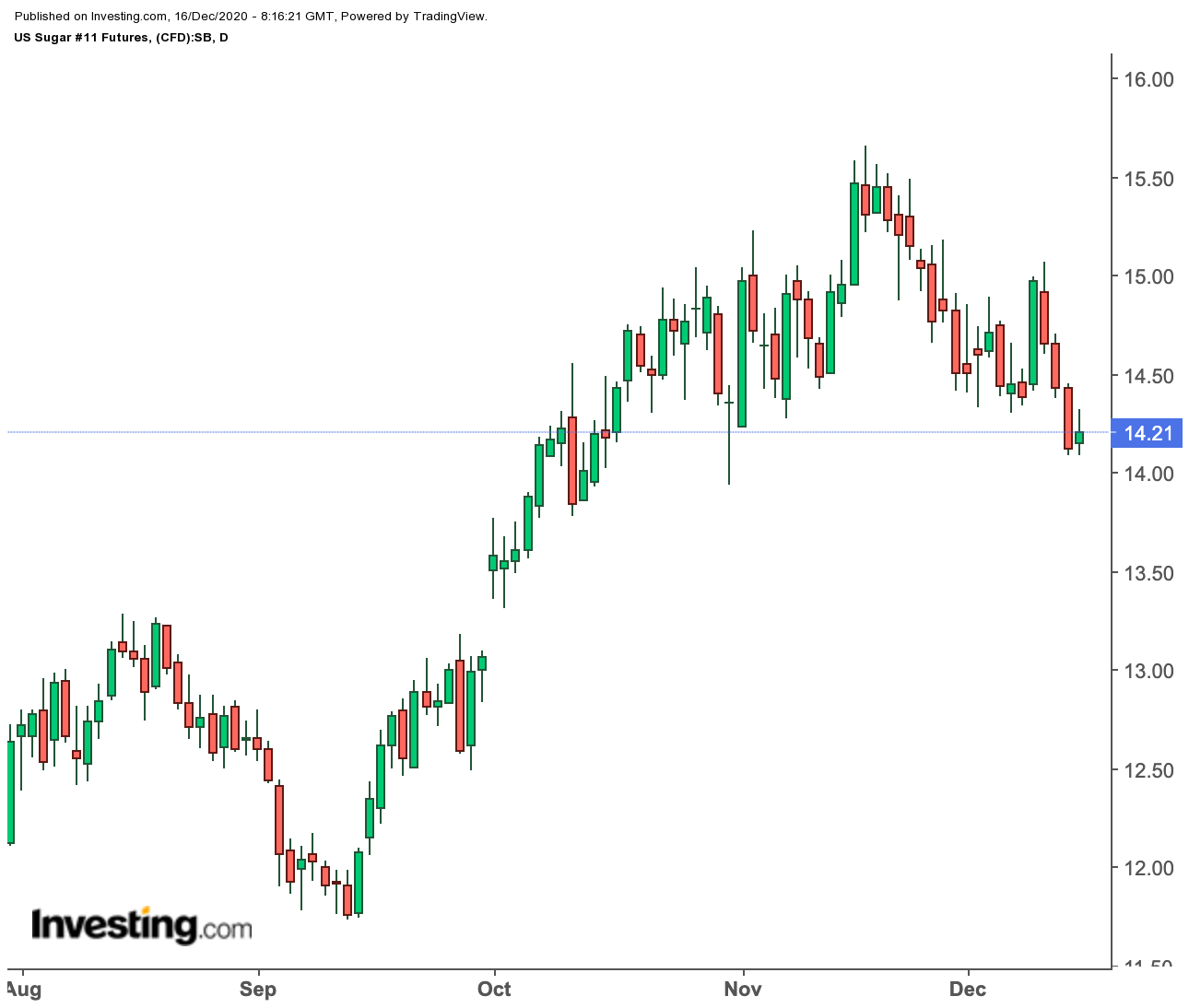Sugar prices have tumbled, on signs of sluggish year-end demand due to a pandemic that’s restricting festivities for 2020. Be that as it may, the seven-week low after a seven-month-long rally may present a sweet buying opportunity.
Why? Because after all that’s said and done, the world economy should begin recovering in the coming months, with COVID-19 vaccines expected to make their slow but steady mark against the coronavirus.
Sugar has two main demand sources: as food and as biofuel. The first may see staggered growth until the rage in infections, hospitalizations and deaths starts to stall. But the latter—involving mostly ethanol, the additive for US gasoline and fuel in many parts of the world—could take off faster based on the runaway rally already evident in crude oil.

In Tuesday’s trade, front-month raw sugar on the US Intercontinental Exchange Futures fell to a seven-week low of 14.09 cents a lb—a 10% decline from lofty, nine-month highs of 15.66 hit exactly a month ago.
This has resulted in a 2% loss so far for raw sugar in December, snapping a seven-month winning streak between May and November that came on the back of serious production issues, which gave longs in the market a whopping 40% gain.
Better Crop Conditions In Brazil
One reason for the market’s weakening is better crop conditions in the main growing countries, Brazil and India, said Jack Scoville, analyst at Chicago’s Price Futures Group brokerage.
Yet, such conditions may not last, meaning the price retreat may not hold either if production issues resurface, said Scoville, who foresees resistance in raw sugar reaching as high as 15.30 if the market reverses.
He explains:
“There are improving weather conditions in Brazil. It has been raining in south central Brazil and the production of cane has been affected. Rains are now spreading north to help the cane in those areas. The first half of November crush was down almost 20% from the previous year as cane production has been hurt due to dry weather earlier in the year.”
Scoville said Brazilian mills also produced more sugar and less ethanol in earlier months due to weak world oil prices then.
Large Indian Cane Harvest This Year
To top that, India has a huge sugarcane harvest coming this year, with the government in New Delhi not announcing any subsidies for exporters of the commodity that has suppressed shipments out of the country.
But the Brazilian demand for ethanol is expected to pick up in 2021, Fitch said in a sugar outlook published last month.
The ratings agency said the expected recovery in average oil prices to $45 a barrel in 2021, from the 2020 average of $41 will increase competitiveness for Brazilian ethanol.
Relaxation of social distancing measures across Brazil will also contribute to higher demand for energy next year, benefiting the cash flows of ethanol producers, Fitch’s Latin America Director Claudio Miori said, adding:
"As sector fundamentals improve, Fitch expects more favorable credit conditions next year following the strong liquidity squeeze in 2020.”
Scoville said Indian export subsidies could also be announced soon, given the urgency and sensitivity of the sugar trade in that country, the discounts may be fairly significant to get shipments moving again.
“Thailand might have less sugar this year due to reduced planted area and erratic rains during the monsoon season. The EU is having problems with its sugarbeets crop due to weather and disease,” Scoville added, referring to other factors that could tighten supply.
Price Turnaround Could Be Significant
In light of all this, where could sugar prices be headed?
Scoville’s Price Futures Group has targets of 14.50, 15.10 and 15.30 for resistance in the near term if the market turns around.
Should the bearish trend extend, then lower support levels could be sought, beginning from 14.00 to 13.80 and 13.70, the brokerage said.
Investing.com’s own Daily Technical Outlook for raw sugar remains at a “Strong Sell” for now, attracting a three-tier Fibonnaci support from 14.17 to 14.15 and through 14.10.
Should the market reverse, then a three-tier Fibonnaci resistance is likely to commence, from 14.27 to 14.29 and through 14.34.
In any case, the pivot point between sell and buy is 14.22.
As with all projections, we urge you to follow the calls but temper them with fundamentals—and moderation—whenever possible.
Disclaimer: Barani Krishnan uses a range of views outside his own to bring diversity to his analysis of any market. He does not own or hold a position in the commodities or securities he writes about.
